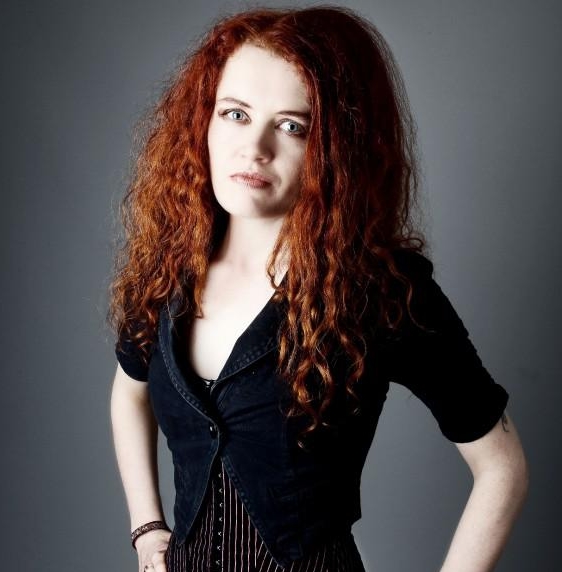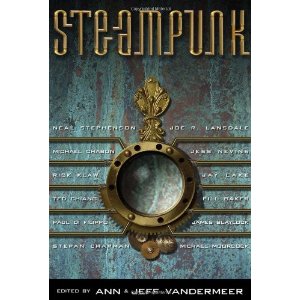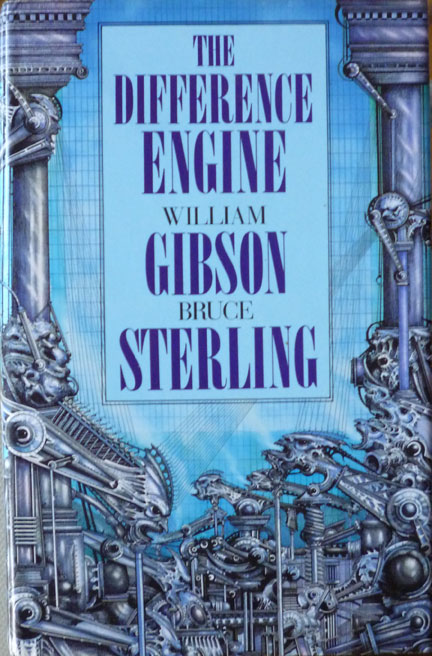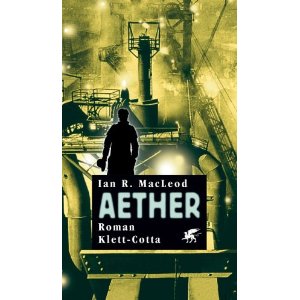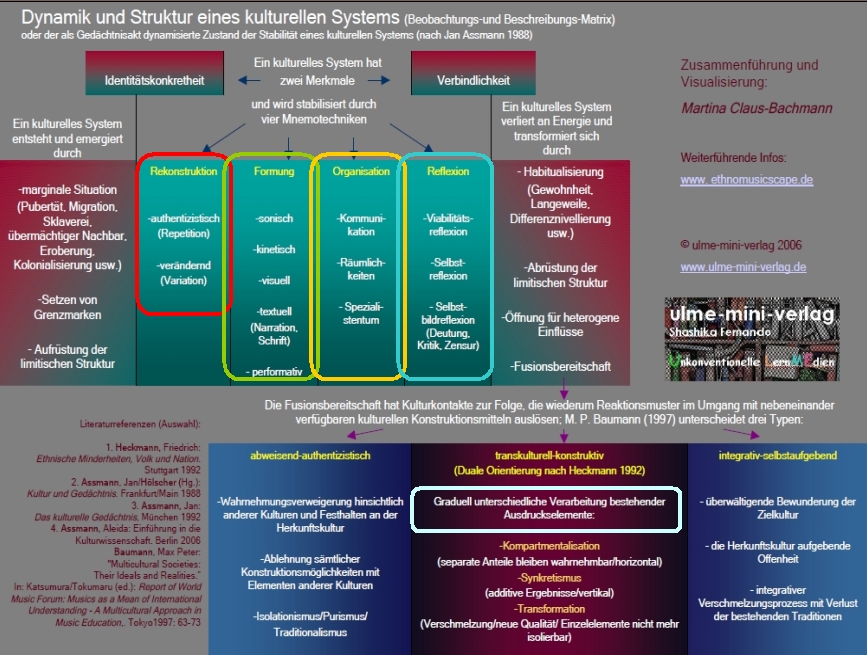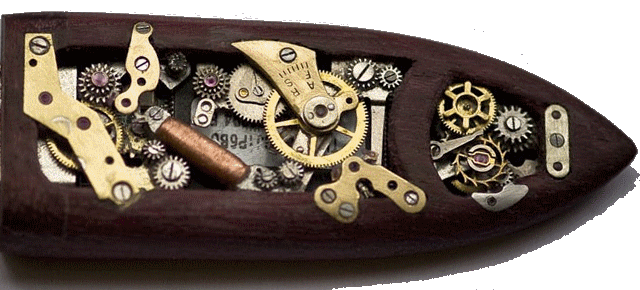Steampunk
– das virtuelle Revival einer Retro-Dystopie und ihre sonische
Gestalt als musikpädagogische Herausforderung
Steampunk
– the virtual Revival of a Retro-Dystopia and its sonic Shape as
a Challenge for Music Education
(überarbeitet am 10.03.2021 und optimiert für Win10 und 1440x900px
video-files are working with Chrome under WIN10 only;
there is no working flash-browser for Android in the moment.)
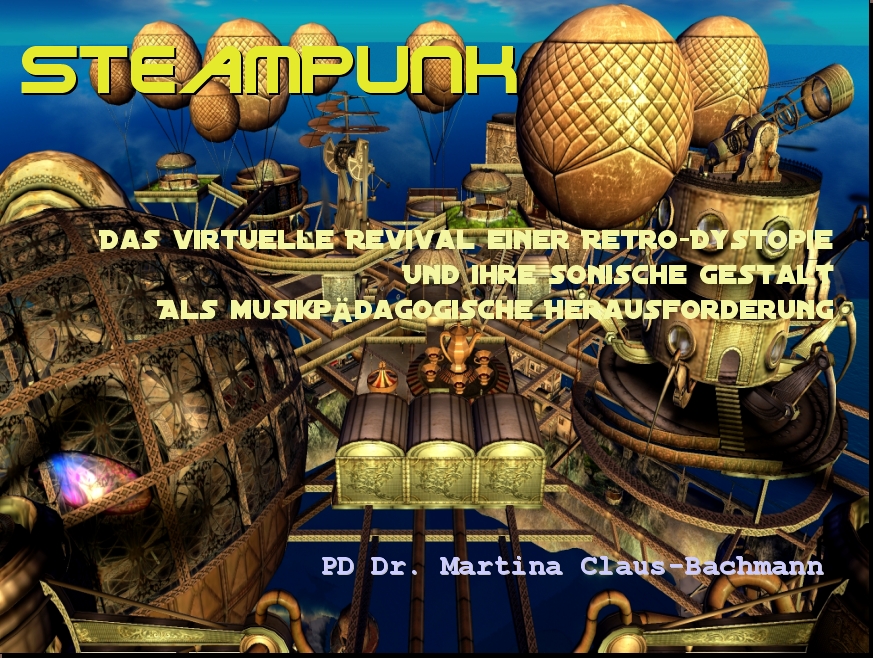 |
Gliederung:
1. Einleitung: Begegnung mit einer Steampunk-Musikerin
2. Methodik und kulturwissenschaftliche Einordnung
3. Die Musik des Steampunk
3.1 Die Klangerzeuger (Thomas Truax u.a.)
3.2 Der Sound von Musikgruppen und Musikern
3.2.1 Abney Park: Under the Radar/Building Steam
3.2.2 Vernian Process: Behold the Machine
3.2.3 Jordan Reyne: The Machines of B.
3.2.3 Pentaphobe: Unknown Hand/So do cerebral
4. Die musikpädagogische Herausforderung
4.1 Immersive Erfahrung musikkultureller Ausdrucksformen des Steampunk in
der Virtualität als Form des eLearning (Jordan Reyne Deezul)
4.2 Das Do-It-Yourself-Prinzip des Steampunk als Anregung zur Handlungsorientierung
im MU (Dr. Steel/We decide it)
4.3 Multi-, Inter- und Transkulturalität im Steampunk als Ausgangspunkt für
diesbezügliche musikpädagogische Erfahrungen (Sunday Driver/Gayatri-Mantra)
4.4 Bewegungsorientierte Musikpädagogik mit der Fusion von Steampunk und
Bellydance (virtuell/Rachel Brice u.a.)
Outline:
1. Introduction: Meeting a Steampunk Singer
2. Methodology and Research Context
3. The Music of Steampunk
3.1 Sound Generators (Thomas Truax e.g.)
3.2 The Sounds of Music Groups and Musicians
3.2.1 Abney Park: Under the Radar/Building Steam
3.2.2 Vernian Process: Behold the Machine
3.2.3 Jordan Reyne: The Machines of B.
3.2.3 Pentaphobe: Unknown Hand/So do cerebral
4. The Challenge for Music Education
4.1 Immersive Experience of Culture related musical Forms of Expression in the Virtuality
as a special Type of eLearning (JordanReyne Deezul)
4.2 The Do-It-Yourself-Principle of Steampunk as a Motivation for
Learning by Doing in Music Education (Dr. Steel/We decide it)
4.3 Multi-, Inter- and Transculturality in Steampunk as a Starting Point for Cultural Experiences
in Music Education (Sunday Driver/Gayatri-Mantra)
4.4 Music Education with a Focus on Movement, Encouraged by the Fusion
of Steampunk and Bellydance (virtual/Rachel Brice u.a.)
Literatur:
Primärliteratur:
Gibson, William/Sterling, Bruce: Die Differenzmaschine.
Heyne, München 1992.
MacLeod, Ian R.: Aether. Klett-Cotta Verlag, Stuttgart 2005.
Sekundärliteratur:
Vandermeer, Ann & Jeff: "Preface - Steampunk: 'It's a
Clockwork Universe, Victoria'". In: Vandermeer, Ann & Jeff (Ed.):
Steampunk. Tachyon Publications, San Francisco 2008:ix/x.
Nevins, Jess: "Introduction: The 19th-Century Roots of Steampunk".
In: Vandermeer, Ann & Jeff (Ed.): Steampunk. Tachyon Publications,
San Francisco 2008:3-11.
Klaw, Rick: "The Steam-Driven Time Machine: A Pop Culture
Survey". In: Vandermeer, Ann & Jeff (Ed.): Steampunk.
Tachyon Publications, San Francisco 2008:349-357.
Baker, Bill: "The Essential Sequential Steampunk: A Modest
Survey of the Genre within the Comic Book Medium". In: Vandermeer,
Ann & Jeff (Ed.): Steampunk. Tachyon Publications, San Francisco
2008:359-368.
Guffey, Elizabeth E.: Retro. The Culture of Revival. Reaction
Books, London 2006.
Keller, Katrin: "Wiederverwertungen. Retro und die Reflexivität
des Reloads". In: Jacke, Christoph/Kimminich, Eva/Schmidt, Siegfried
J. (Hg.): Kulturschutt. Über das Recycling von Theorien und Kulturen.
Bielefeld Transcript:320-332.
Claus-Bachmann, Martina: Musik kulturell vermitteln. Musikpädagogik
und kulturelle Kompetenz. ulme-mini-verlag Gießen 2006.
Schwer, Thilo: "DIY in Jugendsubkulturen. Vom kopierten Fanzine
zum Steampunk-PC". In: inter-cool 3.0. Jugend Bild Medien;
ein Kompendium zur aktuellen Jugendkulturforschung. Paderborn/München
Fink 2010:405-414.
Artikel
in Online-Magazinen:
Sullivan, Caroline: "Tonights I'm gonna party like it's 1899".
In: The Guardian, October 2008: http://www.guardian.co.uk/music/2008/oct/17/popandrock2
Stand 2010
Kegler, Karl R.: "Godzilla trifft Poelzig. Europäische
Kulissen, Kopie und Collage im phantastischen Film Japans": http://www.archimaera.de/2009/raubkopie/godzilla/index_html
Stand 2010
Schwan, Ben: "Viktorianische Subkultur Steampunk: Computer
mit Dampfbetrieb": http://www.taz.de/1/netz/netzkultur/artikel/1/das-grosse-steampunk-treffen/
Schultz, Stefan: "Retro-Kunst. Die wundersame Welt des Steampunk":
http://www.spiegel.de/netzwelt/tech/0,1518,491918,00.html
Ay-leen, the Peacemaker: "Steampunks Around the World, Unite:
Multiculturalism in Steampunk": http://www.steampunkmagazine.com/steampunks-around-the-world-unite-multiculturalism-in-steampunk/
Webpages
mit allgemeinen Informationen:
http://kineticsteamworks.org/
http://www.arte.tv/de/Kultur-entdecken/tracks/2925424.html
http://steampunkexhibition.com/
http://www.steampunkmagazine.com/
Neue
interessante SteamPunk-Musikgruppen:
Off
Limits
Drachenflug
Ausschnitte aus Video-Mitschnitten auf der Plattform YouTube und eigene Aufzeichnungen in der Virtuellen Welt Second Life bzw. bei USTREAM
Abbildungen,
Ausschnitte aus Video-, und Hörbeispielen werden hier als Belege/Zitate
im wissenschaftlichen Sinne verwendet und die Quellen erreicht man durch
Klick auf das jeweilige Bild bzw. auf die angegebene URL. Diese Website
ist nicht kommerziell, sondern dient kulturwissenschaftlichen Zwecken
und möchte zum besseren Verständnis beitragen im Hinblick auf
die multi-, inter- und transkulturellen, physisch-materiell und virtuell
ausgeprägten Kultursysteme unter dem Dach unserer Gesellschaft. Die
Autorin ist promovierte und habilitierte Kulturwissenschaftlerin, Ethnomusikologin
und Musikpädagogin und lehrt als Privatdozentin überwiegend
in ihrer Private Academy for Cultural Studies (PACS) in der virtuellen
Welt Second Life: http://maps.secondlife.com/secondlife/Space%204%20Art/57/112/1000.
Excerpts
from video-recordings on YouTube and the author's own recordings in the
virtual world of Second Life and at USTREAM are used as academic citations
and all sources are accessible by clicking. This webpage is used for academic
purposes in the field of Cultural Studies and does not follow commercial
interests. It tries to contribute a better knowledge concerning the landscape
of the multi-, inter- and transcultural systems under the roof of our
society in the virtuality as well as in the physical-material world. The
author has doctoral and a postdoctoral degrees in the field of Cultural
Studies/Ethnomusicology and Music Education and teaches Cultural Studies
in the virtual world of Second Life: http://maps.secondlife.com/secondlife/Space%204%20Art/57/112/1000.
Many thanks for the native speaker support of Miriam Evanier!
1. Einleitung - Begegnung mit einer Steampunk-Musikerin:
1. Introduction: Meeting a Steampunk Singer
"Ich war als Kind versessen auf Dampfloks und wusste damals noch nicht, dass dies ein Element von 'Steampunk' ist. Musik, die von Steamtechnologie beeinflusst war, habe ich immer gemacht, seit ich anfing und mein erstes Album 1997 erschien. Viele Zuhörer hatten Probleme, meine Musik zu beschreiben. 'Industrial tinged folk music' war ein Versuch. Als ich dann durch Freunde, die Steampunk Storys schrieben, vertrauter mit dem Begriff wurde, war mir klar, was ich schon jahrelang tat: 'digging up old stories and putting them to the sounds of steam, iron and factories'… Die größten Einflüsse kamen von 'Nine Inch Nails', die viel Maschinensound verwenden, und von einer Folk-Gruppe, die sich 'Steeleye Span' nennt und die alte Folksongs sammelt und sie mit modernen Instrumenten reinterpretiert. Nine Inch Nails regte mich an, hinauszugehen und Maschinen-Sounds, Dampfeisenbahnen, und Fabrik-Atmosphäre aufzunehmen, die Klänge und Geräusche aus der Zeit der industriellen Revolution … Ich verwende Dampfgeräusche als perkussives Element in nahezu allen meinen Alben und ebenso das Klirren von Metall und das Zischen von Dampf, alles zusammen wahrscheinlich die typischsten Klangelemente von Steampunk" (Interview Oktober 2010/Gesamt-Interview kann hier als pdf-file abgerufen werden).
Das sagt (in freier Übersetzung aus dem Englischen) die neuseeländische Sängerin Jordan Reyne, die ich nicht etwa im materiell-physischen Leben zum Interview traf, sondern in der virtuellen Welt Second Life, wo sie in den vielfältigen und kulturell aktiven Steampunk Communities im Moment an fünf Tagen der Woche je zweimal eine Stunde auftritt.
"I was very obsessed with steamtrains as a kid (though I didn't know the concept 'steampunk' then) and have been making music that was inspired by steam technology in the real world since I began releasing albums in 1997. Since I began in music people have had trouble describing what I do - 'industrial tinged folk music' was the best description. Then, I came across steampunk via speculative fiction books and author friends who write steampunk novels. It was them who actually put the name to what I had been doing for years - digging up old stories and putting them to the sounds of steam, iron and factories… My two biggest influences would have to be 'Nine Inch Nails' (who use a lot of machine noise) and a folk group called 'Steeleye Span' who collected old folk songs and reinterpreted them using modern instruments. 'Nine Inch Nails' inspired me to go out collecting and recording machinery sounds, and I gravitated towards older, simpler machinery, steamtrains and factory ambiences - the sounds of the industrial revolution time. 'Steeleye Span' gave me the interest in telling tales from different time periods in modern day ways. As in steampunk fiction - I like to take old sounds and the themes of the past and uplift them temporally into the modern world … I use steam as a percussive element in almost all of my albums, and sonically, the grounching of metal and the hiss of steam are possibly the most typical elements of a steampunk aural environment."
This is said by the singer Jordan Reyne from New Zealand. I didn't meet her in the material-physical world for an interview, but in the virtual world of Second Life, where she performs for five days weekly for two hour-sets in the culturally active steampunk sims and clubs.
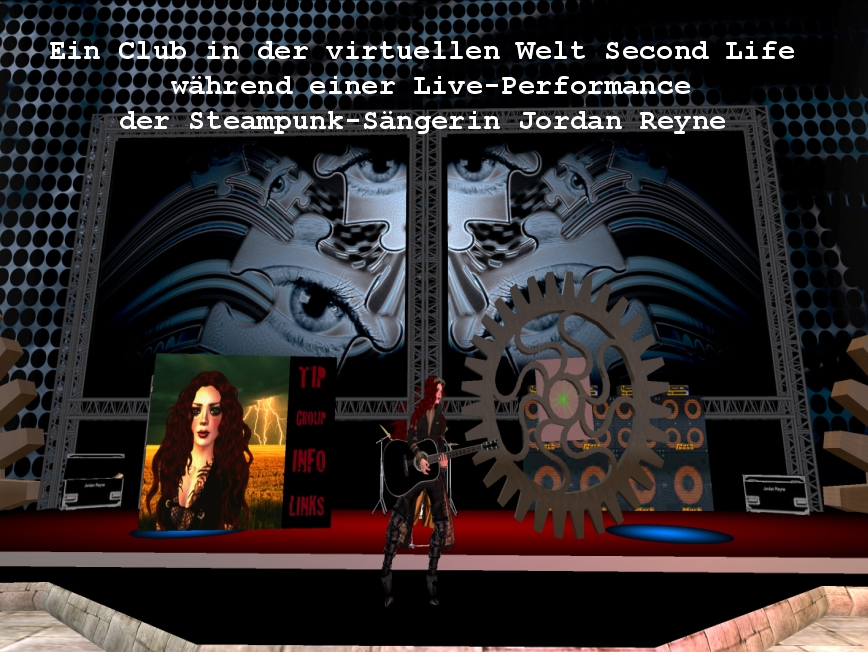 |
Jordan Reyne als Avatar JordanReyne Deezul bei einem Live-Auftritt in einem Club in der virtuellen Welt Second Live
Obwohl Jordan Reyne in Hamburg lebt, hätte ich sie im nicht-virtuellen Leben vermutlich nie getroffen, zumal meine eigenen Erfahrungen mit der Kultur Steampunk überwiegend aus der Virtualität herrühren, wo ich sie seit drei Jahren beobachte. Jordan Reyne nennt ihre virtuelle Gestalt, ihren Avatar JordanReyne Deezul und im folgenden Beispiel tritt sie in einem Club auf, der sich „The Idle Rogue“ nennt. Ihr Song "Not Because" stammt von der CD „The Ironman“, ein Konzeptalbum, in dem es um Marginalität geht:
Although Jordan Reyne lives in Hamburg, I probably wouldn't have met her in the non-virtual life. My own experiences with the Steampunk-culture derive from the virtuality particularly, where I have observed it for three years. Jordan Reyne has named her virtual shape, her avatar, JordanReyne Deezul, and in the following example she performs in a club called "The Idle Rogue." Her song "Not because" appears on the CD "The Ironman," a concept album concerning the topic "marginality":
Jordan Reyne ist sehr medien-affin und zeigt sich regelmäßig live beim Internet-Radio-Anbieter USTREAM, wo man innerhalb ihres Repertoires Maschinensounds und Ambient-Noise gut hören kann:
Jordan Reyne is very media savvy and presents herself on a regular basis with the Internet broadcasting system USTREAM, through which we can hear machine sounds and ambient noise in her repertoire very well:
Was steckt nun allgemein hinter dem Begriff Steampunk und wie kann man ihn kulturwissenschaftlich einordnen?
What is now generally behind the term Steampunk, and how can we qualify it in the research context of Cultural Studies?
2. Methodik
und kulturwissenschaftliche Einordnung
2. Methodology and Research Context
Steampunk, als Begriff zum ersten Mal vom Schriftsteller K. W. Jeter 1987 in einem Artikel für das Magazins Locus verwendet (S. 315), fasziniert in der virtuellen Welt zunächst durch seine Ästhetik:
Steampunk as a term was first used by the author K. W. Jeter in 1987 in an article for the magazine Locus (p. 315), and in the virtual world observers are primarily fascinated by the aesthetics of Steampunk:
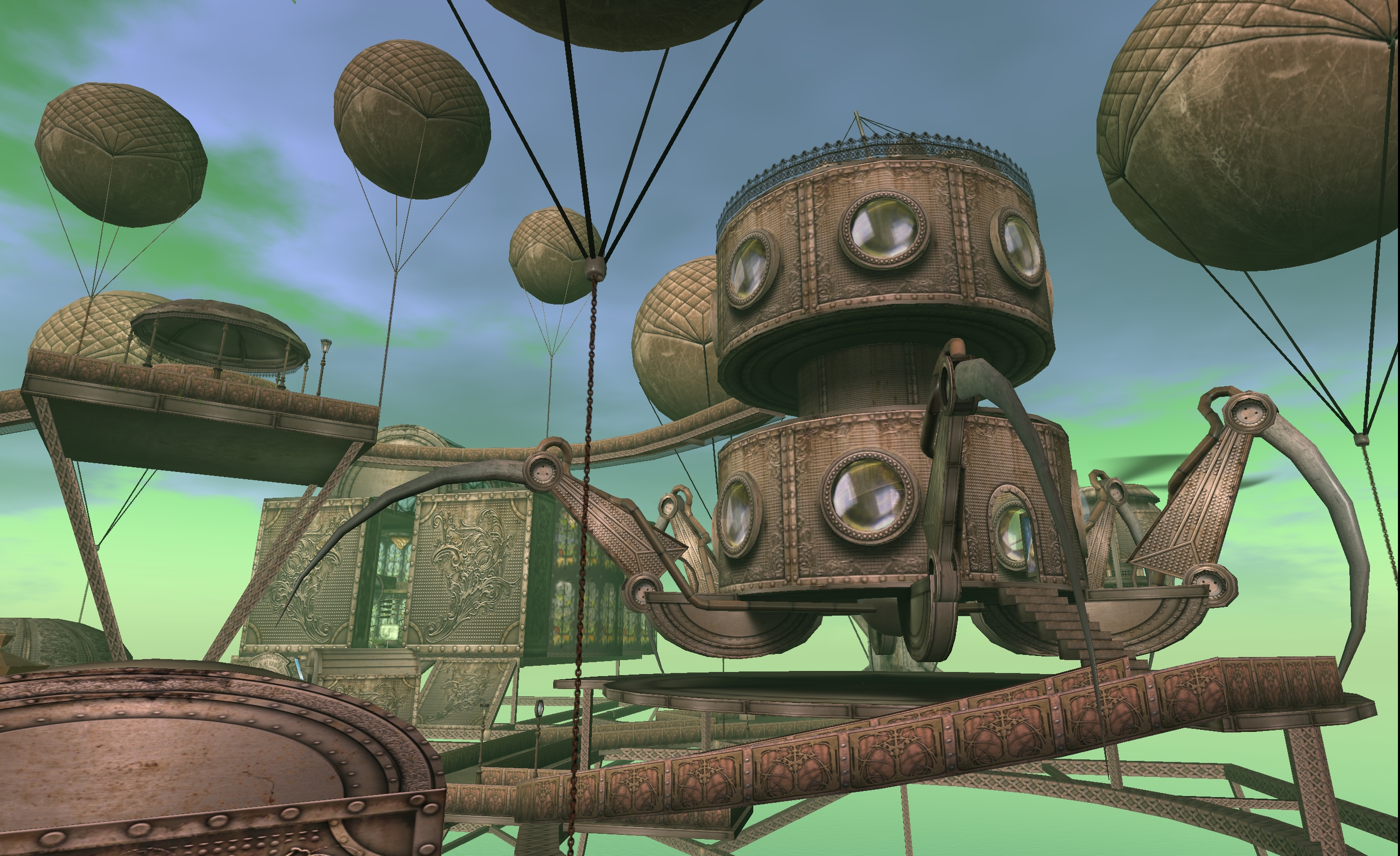 |
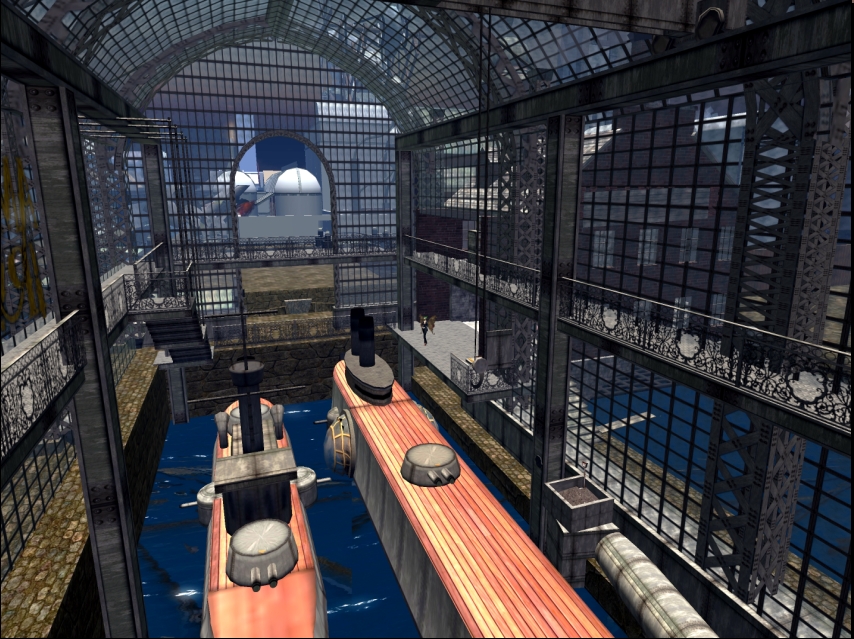 |
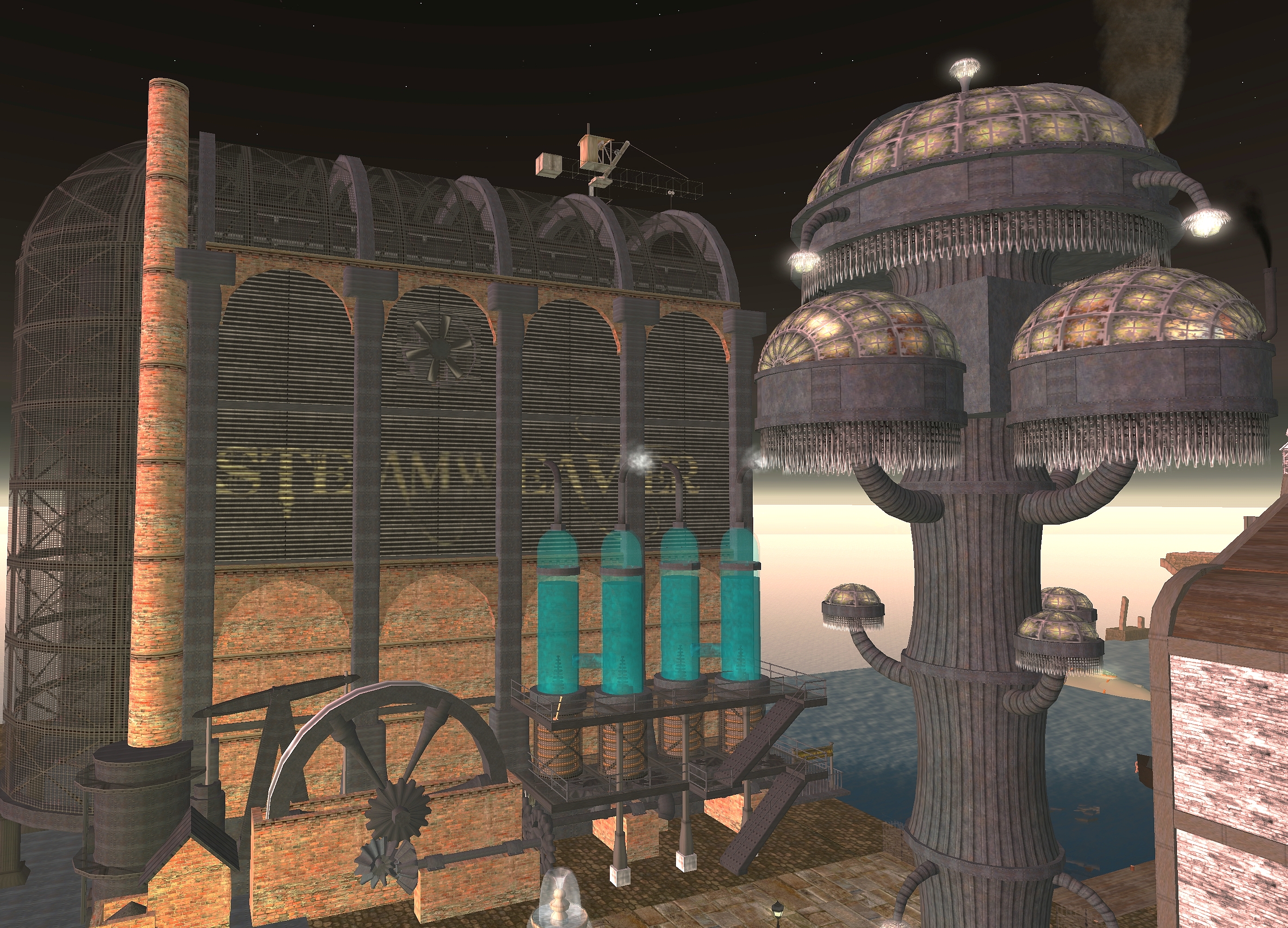 |
Steampunk-Architektur virtuell/virtual Steampunk architecture: Nemo, Port Babbage und/and Babbage Canals in Second Life
Diese drückt sich vor allem in der Inworld-Architektur aus: „Phantasiewelten in viktorianischem Gewand … Flugmaschinen, Computer, Roboter, schwebende Städte oder Weltraumfahrzeuge“ beschreibt sie Karl R. Kegler im Online-Magazin „archimaera“ und sieht die Gestalt von Steampunk als gewachsen aus den sich wechselseitig beeinflussenden Gattungen der phantastischen Literatur, der Film- und Videokunst sowie der Computerspiele. Will man kulturwissenschaftlich recherchieren, sind Artikel, wie der Keglers rar und willkommen, da die akademische Rezeption, besonders im musikbezogenen Forschungsbereich noch aussteht. So ist man auf Quellen der „Recorded Culture“, wie der Begriff bei den Vätern der Cultural Studies Geertz, Williams, Thompson, Hall und Grossberg genannt wird, vor allem im World-Wide-Web, sowie auf qualitative Forschungsmethodik mit Leitfaden-Interviews und Auswertung eigener Beobachtungen (Grounded Theory) angewiesen. Steampunk wird im Moment vor allem in Online-Magazinen, Foren und Communities diskutiert, daneben finden sich einige weiterführende Beiträge in literarischen Anthologien, z.B. der Sammlung „Steampunk“ von Ann und Jeff Vandermeer, und man ist gut beraten, sich innerhalb der Primärliteratur einen Einblick zu verschaffen, etwa mit William Gibsons „Die Differenzmaschine“ oder Ian R. McLeods Roman „Aether“ u.v.a.
These are mainly expressed in the inworld architecture: "Fantasy worlds in a Victorian shape ... flying machines, computers, robots, floating cities or space vehicles" are described by Karl R. Kegler in the online magazine "archimaera," and he sees the shape of steampunk as grown from the interactive influences of the genres of fantastic literature, the art of movies and video clips and of computer games. Carrying out research in the context of Cultural Studies articles like Kegler's are rare and welcome, because the academic reception, especially in the field of music research, was missing until now. Insofar we have to refer to sources of the "recorded culture," as it was named by the fathers of Cultural Studies Geertz, Williams, Thompson, Hall and Grossberg, especially in the world-wide-web. The methodology has to be qualitative, using guided interviews and analysis of personal observation (Grounded Theory). Steampunk is recently particularly discussed in online forums, magazines and communities, as well as in articles published in literary anthologies, e.g., the collection "Steampunk" by Ann and Jeff Vandermeer, and every researcher can profit from reading the primary literature like "The Difference Engine" by William Gibson or Ian R. MacLeod's "Light Ages" etc.
Hier wird schnell klar, dass Steampunk nicht einfach eine Retro-Kultur darstellt, die sich im Revival kultureller Elemente der viktorianischen Zeit (etwa von 1837 bis 1901) erschöpft, sondern ein komplexes hybrides Kultursystem, wie Kegler ausführt:
„Diese Motive knüpfen nicht allein an eine historische Epoche an, sie verarbeiten auch die Traditionen einer literarisch-naturwissenschaftlichen Phantastik, die im 19. Jahrhundert von Autoren wie Jules Verne, Kurd Laßwitz oder H.G. Wells begründet wurde. Während die genannten Autoren in ihrer Zeit aber Imaginationen alternativer Zukünfte schrieben, projiziert das Genre des Steam Punk wirkliche Errungenschaften und technische Fiktionen unserer Zeit in eine imaginierte Vergangenheit. Diese anachronistische Collage von Ungleichzeitigem lebt von der Kunst, die heterogenen Elemente in einem schlüssigen ästhetischen Konzept zu vereinen, in dem historisches Vorbild, verfremdete Kopie und Fiktion eine enge Verbindung eingehen. Der ästhetische Reiz besteht im Spiel des Wiedererkennens und Überrascht-Werdens, wenn Vertrautes in verfremdeter, Fiktionales in vertrauter Form repräsentiert wird. Dies gilt nicht allein für historische und fiktive Technik, die in diesen Phantasiewelten in viktorianischem Gewand ihren Auftritt findet, sondern auch für Architekturen, Stadt- und Landschaftsbilder“.
Here the reader will easyly discover, that Steampunk is not only a retro culture reviving the cultural elements of the Victorian era (about 1837 to 1901), but also a complex hybrid cultural system, as Kegler explains:
"These motifs don't only follow a historical era, they also process the traditions of a literary-scientific science-and-fantasy fiction, which was founded in the 19th century by authors like Jules Verne, Kurd Laßwitz or H.G. Wells. Whilst the mentioned authors wrote in their time imaginations of alternative futures, the genre of Steampunk projects real achievements and technical fictions of our time into an imagined past. This anachronistic collage of the non-synchronic arises from the art, to unify heterogeneous elements in a conclusive aesthetical concept in which the historical model, the alienated copy and fiction are closely merged. The aesthetical attraction can be found in the game of recognising and being surprised, when familiar things are represented in an alienated and fictional ideas in a familiar shape. This doesn't apply only for a historical and imagined technique, which is presented in a Victorian shape, but also for architecture, pictures of cities and landscapes" (free translation).
Und natürlich
auch für die Musik, können wir ergänzen. Jordan Reyne drückt
das im Interview so aus: „One of the key aspects of Steampunk, in
my understanding of it, is that focus on steam era stories and the temporal
displacement of them into a future or modern world“.
Stefan Schultz fasst in seinem Artikel „Die
wundersame Welt der Steampunks“ im Spiegel-Online-Magazin zusammen:
„Ästhetisch befassen sich Steampunks mit der Idee, wie die heutige
Welt aussähe, wenn Dampf statt Elektrizität sie in Bewegung
hielte. Wenn nicht nur Eisenbahnen mit Dampfmaschinen angetrieben würden,
sondern auch Computer, Raumschiffe und Luftfahrzeuge. Wenn überall
dort Messing und Kupfer zu finden wäre, wo heute Plastik drinsteckt.
Es ist im Prinzip unsere Welt, sie ist nur in der Vergangenheit einmal
anders abgebogen“. Selten führen diese Abzweigungen in heile
Welten, sondern vorherrschend ist trotz aller Schönheiten die dystopische
Färbung der Ausdrucksformen, sei es in den literarischen Vorlagen
oder sonstwo. Ian R. McLeods Aether verleiht zwar magische Fähigkeiten
und sichert die Energieversorgung, ist jedoch ebenso gesundheitsschädlich
und für die Menschheit weder kalkulier- noch beherrschbar. Assoziationen
zur aktuellen Debatte um Atomenergie drängen sich auf.
Endzeit-Phantasien, Diktaturen, verseuchte Orte der Einsamkeit sind Themen
von Literatur, Film und virtuellen Welten und auch deren Steampunk-Details
sind durch marode Texturen, Grunge-Optik und düstere Klänge
bestimmt. Der Punk-Anteil am Steampunk ist verbunden mit diesen dystopischen
Kennzeichen. Es gibt auch das Gegenteil, die Steam-Utopien, doch werden
diese als Steam-Fantasy bezeichnet.
One
could add that it also applies to the music. Jordan Reyne explains in
the interview: „One of the key aspects of Steampunk, in my understanding
of it, is that focus on steam era stories and the temporal displacement
of them into a future or modern world."
Stefan Schultz concludes in his article "The wondrous World of the
Steampunks" in the Spiegel-Online-Magazine: "Aesthetically the
Steampunks focus on the idea, what the recent world would look like, if
steam moved it instead of electricity. If not only railway trains would
be operated by steam but also computers, space ships and air vehicles.
If everything which is produced of plastic today would consist of brass
and copper. It is principally our world today, but it has taken another
direction in the past" (free translation). Rarely does this side
road result in an ideal world, and despite all beauty the dystopic colouring
of the forms of expression is dominant, whether in literary examples or
elsewhere. Ian R. MacLeod's "aether" grants magical abilities
and ensures the energy supply on one hand, but is on the other hand dangerous
for the health and difficult for the humans to calculate or control. Associations
with the actual debate on nuclear power come to mind. Endtime fantasies,
dictatorship, polluted places of loneliness are the topics of literature,
films and virtual worlds and the steampunk details are represented by
distressed textures, grungy visual appearance and dark sounds. The Punk
part of Steam"punk" is connected with these dystopian characteristics.
The opposite also exists, the steam utopies, but these are called steam-fantasy.
Die Philosophie, die Steampunk ausmacht ist eine konstruktivistische im wahrsten Sinne; immer wieder stößt man auf die Do-It-Yourself-Konzeption. Sie ist in Songtexten und besonders in den Manifesten eines kabarettistischen Allround-Künstlers zu finden, der sich Dr. Steel nennt. Sein Song We decide it macht auf die Verantwortlichkeit jedes einzelnen für seine Lebenswelt aufmerksam:
The philosophy behind Steampunk is constructivist in the true sense of the word; everywhere we can find the concept of do-it-yourself. It is presented in song lyrics and especially in the so called manifests of an all-round cabaret artist with the name Dr. Steel. His song "We decide it" reminds the individual of his/her responsibility for his/her own living environment:
Dr. Steel verkündet
nicht ohne Selbstironie seine Idee in mehreren
Kapiteln/ Dr.
Steel announces his idea in several chapters not without self irony:
"...
a new world view must begin to take place. Dr. Steel believes that such
a revolution begins with the individual's perception of reality ... A
Utopian Playland isn't simply a physical incarnation, it is a psychological
one. It is a way of looking at one's reality. Building a Utopian Playland
must begin from within before we march forth towards this grand, new horizon
... Putting the 'fun' back in functional is Dr. Steel's vision. A Utopian
Playland incorporates the pleasing aesthetics and entertainment of a theme
park with the needs and functionality of a well designed community ...
Being a designer of toys, I enjoy developing and bringing to life new
creations that others will enjoy experiencing. However much I enjoy the
creation process of such toys, it would be far too short sighted to believe
that simply producing more toys for the world would solve all of our problems.
No, toys are but a stepping stone in traversing a long and winding road
to the new world...."
Überprüft man den System-Status der Steampunk-Kultur mit der in meiner Habilitationsschrift und auf der Webpage EthnoMusicScape in fünf multimedial-interaktiven Modulen entwickelten systemischen Beobachtungs- und Beschreibungmatrix, so wird deutlich, dass Steampunk die Entstehungsphase überwunden hat, sich am Anfang der Stabilisierungsphase befindet und seine kulturellen Formanten sowohl in der physisch-materiellen Welt als auch in der virtuellen ausgeprägt hat. Der Beobachter trifft somit auf textuelle, visuelle, sonische, kinetische und performative kulturelle Formationen. Er kann das Spiel der Rekonstruktion zwischen Authentizismus und Variation wahrnehmen, sieht, wie sich das kulturelle System durch Kommunikation, Räumlichkeiten und Spezialistentum organisiert und das ganz besonders mithilfe des Internets und wie sich langsam ein reflexiver Diskurs aufbaut. Auf der anderen Seite zeigt sich Steampunk gerade im sonischen Bereich noch fusionsoffen, experimentierfreudig und für heterogenste Mixturen empfänglich.
If we verify the system status of the Steampunk culture with the matrix of observation and description developed in my postdoctoral thesis and presented on the webpage www.ethnomusicscape.de in five interactive multimedia modules, then we can see that Steampunk has left the period of emergence and is now going to stabilize its cultural formants in the non-virtual world as well as in the virtuality. The observer can find textual, visual, sonic, kinetic and performative cultural formations. He can perceive the game of reconstruction between authenticism and variation, can realize how the cultural system is organised by communication, spatiality and specialisation of people especially with the help of the Internet and how a reflexive discourse is slowly developed. On the other hand, Steampunk still seems to be open for fusions, keen on making experiments and susceptible to most heterogeneous mixtures.
KulturSystemMatrix/matrix of cultural systems in English s.a. hier
copyright ulme-mini-verlag 2010
